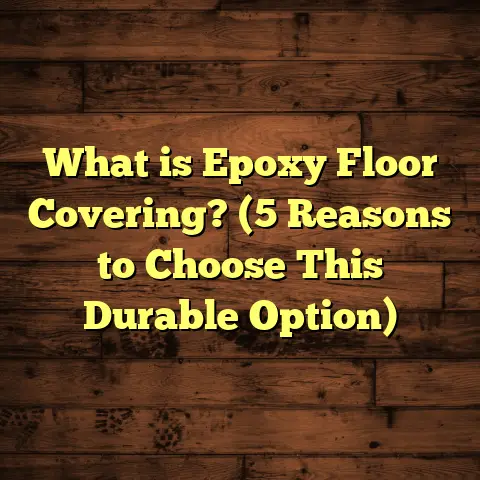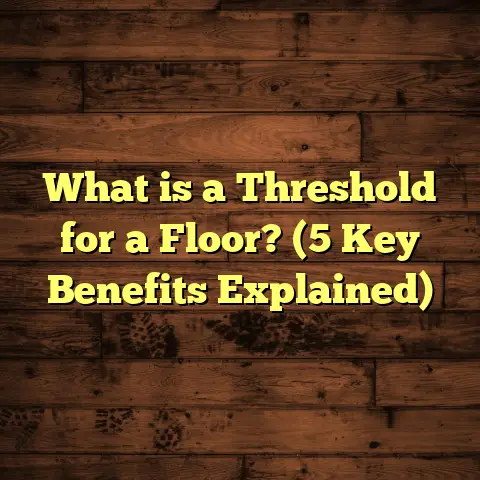What is SPC Hybrid Flooring? (5 Benefits You Need to Know)
I’ve always been drawn to the aesthetics of a home’s flooring. There’s something about how it sets the tone for the entire space—whether it’s cozy, modern, or somewhere in between. Over the years, I’ve worked with many types of floors, but a product that really caught my attention recently is SPC hybrid flooring. It’s been gaining traction, and I’ve gotten a lot of questions about it. So, I want to share what I’ve learned, including some benefits you might not have heard about.
What is SPC Hybrid Flooring?
SPC stands for Stone Plastic Composite. At its core, SPC hybrid flooring is a type of rigid vinyl flooring that combines natural limestone powder with stabilizers and polyvinyl chloride (PVC) to create a super-durable core. This core is what sets it apart from traditional vinyl or laminate flooring.
It’s called “hybrid” because it blends the best qualities of several types of flooring—offering durability, water resistance, and an authentic look that mimics hardwood or stone but at a fraction of the maintenance hassle.
The top layer is usually a photographic film that replicates the look of wood or stone textures, covered by a transparent wear layer that protects against scratches and stains. Underneath this wear layer is the SPC core, which gives it incredible stability and resistance to dents. This combination means SPC hybrid flooring is designed for both style and long-lasting performance.
Breaking Down the Layers
To really understand why SPC hybrid flooring is different, it helps to know the layers that make it up:
- Wear Layer: This is the topmost layer and is crucial for durability. It’s transparent and protects the flooring from scratches, stains, and fading.
- Design Layer: Beneath the wear layer sits a high-resolution photographic layer that replicates wood grain, stone veins, or other patterns.
- SPC Core: The heart of this flooring. Made from limestone powder mixed with PVC and stabilizers, this core is incredibly dense and rigid. It’s what provides waterproofing and resistance to dents.
- Backing Layer: This bottom layer adds stability and sound insulation while helping with moisture resistance from below.
This construction makes SPC hybrid flooring very stable underfoot compared to vinyl planks or laminate flooring that have softer cores.
Why “Hybrid”?
You might wonder why it’s called “hybrid” when it’s essentially a type of vinyl flooring. The name comes from its combination of materials—stone powder mixed with plastic—to create a product that is more rigid and stable than traditional vinyl but still flexible enough for easy installation. It borrows durability traits from stone and ease-of-use from vinyl.
Why I Started Using SPC Hybrid Flooring
When I first encountered SPC hybrid flooring on a project, I was curious about how it would perform compared to other options like vinyl plank or laminate. I was working on a kitchen renovation where water resistance was a priority—especially around the sink and dishwasher area.
The homeowners wanted something that looked like real wood but wouldn’t warp or swell if water spilled. After some research and testing samples, I decided to install SPC hybrid flooring there. The results were impressive: the floor maintained its appearance and integrity even after weeks of heavy use.
This experience showed me that SPC hybrid flooring isn’t just hype—it can handle tough conditions without sacrificing style.
I remember the family telling me how relieved they were not to worry about water damage anymore. It was a big win in their busy household with kids who sometimes left spills behind. That project made me a firm believer in this product, especially for areas where durability and moisture resistance are key.
5 Benefits You Need to Know About SPC Hybrid Flooring
Let me walk you through five benefits that convinced me—and many others—to consider SPC hybrid flooring seriously.
1. Water and Moisture Resistance
One of the standout features of SPC hybrid flooring is its water resistance. Unlike traditional hardwood or laminate floors that can swell or warp when exposed to moisture, SPC’s dense core is waterproof.
I’ve installed this flooring in bathrooms and basements where moisture tends to be a problem. It held up beautifully with no signs of damage over time. According to industry sources, SPC floors typically have a moisture resistance rating above 99%, making them ideal for areas prone to spills or humidity.
This moisture-proof quality means you don’t have to stress over minor accidents like dropped drinks or steam from showers. It also resists mold and mildew growth better than wood-based materials.
In one project I worked on in a coastal home where humidity levels were consistently high, SPC floors remained flawless after several months—even after heavy rains caused some flooding nearby.
2. Durability That Holds Up to Daily Wear
Durability is another reason I favor SPC flooring. The rigid core provides excellent resistance to dents from heavy furniture or dropped objects. Plus, the wear layer protects against scratches from pets or foot traffic.
In my experience, this flooring can last over 20 years with proper care—sometimes longer than laminate or traditional vinyl planks. Some brands offer wear layers up to 40 mil thick, which translates into better protection for high-traffic homes.
Let me share an example: A couple I worked with had two large dogs that loved running inside on hardwood floors before switching to SPC hybrid flooring in their living room. After two years, there were no scratches or visible wear despite the dogs’ claws.
That kind of toughness can save money in the long run by avoiding premature replacement or costly repairs.
3. Easy Installation
If you’ve ever installed flooring yourself or watched pros at work, you know how important ease of installation is. SPC hybrid flooring often uses a click-lock system that snaps boards together without glue or nails.
I’ve found this makes installation faster and cleaner. On one project, my crew installed over 1,000 square feet in just two days with minimal waste thanks to the precise fit.
The rigid core also helps keep boards flat without warping during installation—a common challenge with laminate floors that can cup or bow if not installed properly.
From my perspective as both a contractor and homeowner, this ease reduces labor costs and makes DIY projects more accessible for those willing to try it themselves.
4. Realistic Look and Feel
A lot of people ask me if SPC floors feel “fake.” Honestly, when done right, these floors can look incredibly close to real hardwood or stone.
The photographic layer on top has improved drastically in recent years. Some manufacturers use high-definition imaging combined with textured surfaces that mimic wood grain or stone veins perfectly.
I remember clients who initially doubted the appearance ended up loving their floors once installed. It’s a great option if you want style without the high cost or maintenance of natural materials.
What surprised me was how natural these floors felt underfoot too—not plasticky or hollow like some vinyls can feel. The dense core gives them weight and stability that feels solid when walking barefoot.
5. Cost-Effective Without Sacrificing Quality
From my viewpoint, one of the biggest selling points is value for money. SPC hybrid flooring often costs less upfront than hardwood or engineered wood but lasts longer than traditional vinyl or laminate.
When budgeting for projects, this balance between price and durability really stands out. To get accurate estimates for material and labor costs, I use FloorTally—it helps me factor in local rates and waste percentages so I don’t get caught off guard by expenses.
For example, on average in the U.S., SPC flooring costs between $3 and $7 per square foot for materials alone. Installation adds another $2 to $5 per square foot depending on region and complexity. Using FloorTally has saved me hours on calculations and made quoting clients more transparent.
I’ve also noticed that because installation time is shorter than with tile or hardwood, overall project timelines shrink—which means less disruption for homeowners.
Diving Deeper: Understanding SPC Flooring Performance Metrics
If you’re like me, numbers help make decisions clearer. So let me share some data points about SPC hybrid flooring’s performance compared to other options:
- Scratch Resistance: ASTM F1515 test results show wear layers above 20 mil can withstand moderate scratching from everyday objects like shoes or pet claws.
- Indentation Resistance: According to ASTM F1914 standards, SPC floors with a rigid core can resist indentation from furniture legs up to 500 psi without permanent damage.
- Water Absorption: SPC has near-zero water absorption rates (<0.01%), compared to laminate which can absorb up to 8% moisture causing swelling.
- Fire Resistance: Many SPC products meet Class B fire ratings (ASTM E84), which means they are less likely to contribute to fire spread compared to carpet or wood.
- Sound Insulation: With appropriate underlayment, SPC floors reduce impact noise by up to 20 dB—great for multi-story homes or apartments.
These figures come from lab tests and real-world installations I’ve tracked over time.
Personal Stories From My Flooring Projects
When I started installing SPC hybrid floors more regularly, I began noticing patterns in client satisfaction that go beyond just technical specs.
One memorable project involved a young couple renovating their downtown apartment. They wanted something stylish yet durable enough for their active lifestyle—cooking often and hosting friends regularly. After choosing an oak-look SPC floor, they told me six months later how much easier cleaning was compared to carpet or wood they had before.
Another example: An elderly client was nervous about slipping hazards with tile in her kitchen but didn’t want to sacrifice appearance. We installed SPC hybrid flooring with a textured surface that offered grip without looking industrial. She reported feeling safer walking around her home day-to-day.
These stories show how versatile SPC flooring can be across different lifestyles and needs.
How Does SPC Hybrid Flooring Compare to Other Options?
Let’s compare SPC hybrid flooring to some common alternatives:
| Flooring Type | Water Resistance | Durability | Cost Range (Material + Installation) | Aesthetic Realism | Maintenance |
|---|---|---|---|---|---|
| SPC Hybrid Flooring | Excellent | High | $5 – $12/sq ft | Very Good | Low (easy cleaning) |
| Hardwood | Poor | Moderate-High | $8 – $15/sq ft | Excellent | High (refinishing) |
| Laminate | Moderate | Moderate | $3 – $8/sq ft | Good | Moderate |
| Luxury Vinyl Plank | Good | Moderate-High | $3 – $7/sq ft | Good | Low |
| Tile | Excellent | Very High | $7 – $15/sq ft | Variable | Moderate (grout care) |
Hardwood vs SPC Hybrid Flooring
Hardwood offers timeless beauty but is vulnerable to moisture damage unless sealed perfectly—and even then it needs regular refinishing every 7-10 years depending on wear.
SPC gives you a similar look without worrying about dents from pet claws or water spills. The initial cost is lower too, though hardwood may add resale value in some markets.
Laminate vs SPC Hybrid Flooring
Laminate is another budget-friendly option with decent looks but tends to swell significantly if exposed to water—even small amounts through seams can cause issues over time.
SPC’s waterproof core solves this problem while offering comparable scratch resistance and easier installation due to rigidity.
Luxury Vinyl Plank vs SPC Hybrid Flooring
Luxury Vinyl Plank (LVP) shares many qualities with SPC since both are vinyl-based. However, LVP typically has a softer core which can dent under heavy impact more easily.
SPC’s stone composite core makes it stiffer and less prone to visible damage while giving better sound insulation when combined with underlayment.
Tile vs SPC Hybrid Flooring
Tile is extremely durable and waterproof but tends to feel cold and hard underfoot unless heated systems are installed—which adds cost.
SPC offers warmth closer to wood feel plus simpler installation on uneven subfloors since it doesn’t require mortar like tile does.
Installation Tips From My Experience
If you decide on SPC hybrid flooring for your home or project, here are some tips I’ve picked up over time:
- Acclimate Before Installation: Let your planks sit in the room where they’ll be installed for at least 48 hours so they adjust to temperature and humidity.
- Subfloor Preparation Matters: Ensure your subfloor is clean, dry, flat (within 3/16 inch over 10 feet), and free of debris.
- Use Underlayment If Needed: Some SPC products come with attached underlayment; if not, adding one improves sound absorption and comfort.
- Leave Expansion Gaps: Even though SPC doesn’t expand much, leave at least 1/4 inch gap around walls for natural movement.
- Clean Tools Ready: Use proper spacers, tapping blocks, pull bars designed for click-lock systems.
- Avoid Sharp Impacts: While durable, avoid dropping heavy tools during installation as extreme impact can crack boards.
- Seal Transitions: Where SPC meets tile or carpet, use transition strips for smooth edges preventing trip hazards.
Caring For Your SPC Hybrid Floor
Maintenance is pretty straightforward but here’s what I always tell clients:
- Sweep or vacuum regularly using soft attachments.
- Mop occasionally with damp cloths—not soaking wet.
- Avoid harsh cleaners containing ammonia or bleach.
- Use felt pads under furniture legs.
- Clean spills promptly even though water won’t damage core—it prevents stains.
- Avoid steam cleaners as excessive heat may degrade wear layer over time.
Following these simple steps keeps your floor looking fresh for years without professional refinishing required like with hardwoods.
Environmental Impact Considerations
I’m aware sustainability matters more now than ever when choosing materials for homes. While vinyl products get mixed reviews environmentally due to PVC content, some brands are making strides:
- Low VOC emissions certified products improve indoor air quality.
- Some manufacturers use recycled content in cores.
- Longer lifespan reduces waste from frequent replacements.
- Proper disposal programs are emerging for vinyl waste recycling.
If environmental impact is a top priority for you, ask suppliers about certifications such as FloorScore® or GREENGUARD Gold which indicate safer indoor emissions levels.
Frequently Asked Questions About SPC Hybrid Flooring
Let me answer some questions I hear often:
Q: Can I install SPC hybrid flooring over existing floors?
A: Yes! It’s commonly installed over concrete slabs, plywood subfloors, ceramic tile, or even existing vinyl if flat and sound.
Q: Is it noisy walking on SPC floors?
A: They can be quieter than laminate but may produce slight clicking sounds without underlayment. Adding foam underlayment reduces noise dramatically.
Q: Can I install SPC flooring myself?
A: Absolutely! The click-lock system is user-friendly for DIYers with basic tools and patience.
Q: How long does SPC flooring last?
A: Typically 15-25 years depending on use and wear layer thickness; commercial-grade options last even longer.
Q: Is it safe for pets?
A: Yes! Scratch-resistant surfaces withstand claws well; just keep nails trimmed as usual.
My Final Thoughts After Years of Working With Floors
Looking back at my journey from hardwood installations decades ago through laminate experiments to discovering SPC hybrid flooring—I see it as an excellent middle ground solution that solves many common problems homeowners face:
- It offers durability beyond what many expect in vinyl products.
- It handles water exposure better than wood or laminate.
- It looks realistic enough not to compromise on aesthetics.
- It installs quickly without costly tools or adhesives.
- And it fits well within reasonable budgets without sacrificing quality.
If you’re debating between various floor types for your next project—or simply curious about new options—SPC hybrid flooring deserves serious thought alongside other materials like engineered hardwood or luxury vinyl plank.
And if you want help crunching numbers based on your specific space dimensions and local labor rates, tools like FloorTally make life easier by providing precise estimates quickly so you can plan smartly without surprises later on.
Flooring changes how we live in our spaces—it should combine beauty with performance seamlessly. For many situations I’ve faced personally and professionally, SPC hybrid flooring checks those boxes nicely. If you have more questions or want advice tailored to your home needs, just ask—I’m happy to help!





